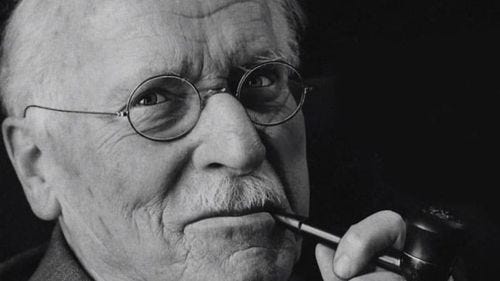9. Carl Jung's Guide to Synchronicity: Beyond Coincidence
Exploring Carl Jung, Freud, meaning, gravity, the golden scarab, fish symbolism, plum pudding, Steve Jobs & so much more...
Setting the scene
This newsletter is intended to act as an introduction and summary of a principle known as 'synchronicity'. Rather than focus on definitions and the underlying theories behind this phenomenon, we will explore a few examples described by Carl Jung himself in the book titled "Synchronicity: an acausal connecting principle".
For the logical mind, the pursuit of knowledge often centers around empirical evidence and verifiable causality. Therefore, the innate desire to be hesitant and healthily skeptical is only natural. That being said, one may also argue that what we do not know, exceeds that which we do know.
Therefore, trying to understand ourselves, the people around us, and the world as a whole using solely the tools we currently have available, is likely to derive unsatisfactory results. One should also try to be mindful of the way society has programmed him/her to believe or outright dismiss certain ideas.
To better understand this, it is best to look at historical examples of such misconceptions. For example, if you tried to explain to someone that the tides on Earth are impacted by the moon, you would have been called crazy as there is no intuitive connection between the two. People believed that magic, sea monsters, or some mystical element were at play.
It was only following the discovery of gravity by Sir Isaac Newton that we understood that the gravitational pull of the moon is the primary driver of tides on Earth. This highlights the difficulty of trying to grasp certain concepts given the amount of 'gravity' equivalent discoveries that are yet to occur, which is why it would be wise to not be immediately dismissive of new ideas.
What are Synchronicities?
“Synchronicity is an ever-present reality for those who have eyes to see” - Carl Jung
Synchronicity is a term coined by Swiss psychiatrist and psychoanalyst Carl Jung. It refers to a meaningful coincidence that happens when an inner psychological state of the mind corresponds to an event in the world i.e. where 2 or more events are not causally related but share a significant and meaningful connection.
The outer world events and inner psychological experiences of an individual are interconnected in a way that transcends the notion of 'cause and effect'. Consider that the examples to be presented are by their nature reliant on the reliability of the narrator.
Carl Jung is the founder of analytical psychology, a branch of psychoanalysis that explores the individual's unconscious, dreams, and symbolism. He had a close relationship with Sigmund Freud (the father of psychoanalysis) and was viewed as his natural successor, however, they grew apart as Jung wanted to explore his own theories.
Jung went on to introduce several innovative concepts such as the terms introvert, extrovert, collective unconscious, and archetypes. These have become fundamental within modern psychology, helping several patients and inspiring subsequent generations of psychologists and researchers along the way.
The Golden Scarab
Jung recounts a therapy session with a highly educated and rational woman who had been resisting dealing with her feelings and emotions, seeing two other therapists beforehand who could not get through to her. As she was recounting her dream, in which she was given a piece of jewelry in the form of a golden scarab (beetle), Jung heard a gentle tapping on the closed window behind him and saw a flying insect knocking against the window from outside.
As he opened the window, he caught the creature. It was a scarabaeoid beetle which is virtually identical to the golden scarab and is rarely found within that latitude. Contrary to its usual habits, it felt the urge to get into a dark room at that particular moment in time.
The timing and improbability of such an event, allowed the woman to stop intellectualising matters and begin making real progress in her growth toward wholeness. The universe somehow facilitated her therapy by giving her a meaningful coincidence that she could not rationalise away. Additionally, it is important to note that the scarab is a classic example of the rebirth symbol, commonly referred to in Ancient Egypt.
Fish
On 1/04/1949 Jung made a note of an inscription including the word 'fish' in Latin, later proceeding to eat fish for lunch. Somebody then mentions the custom of making an ‘April fish’ of someone. In the afternoon, a former patient of Jung whom he had not seen in months showed him some impressive pictures of fish that she had painted. In the evening, Jung was shown a piece of embroidery with fish-like monsters in it.
On the morning of April 2nd another patient, whom Jung had not seen for many years, told him of a dream in which she stood on the shore of a lake and saw a large fish that swam towards her and landed at her feet. At this time, Jung also happened to be engaged in a deep study of the fish symbol within history and in particular, Christianity. Jung highlighted that only one of the persons mentioned here knew anything about this research.
A few weeks later, Jung sat by a lake to write about this set of coincidences occurring within such a short span of time, all revolving around fish. Just as he finished the final sentence, he walked over to the sea wall and there lay a dead fish about a foot long, apparently uninjured. No fish had been there the previous evening (presumably it had been pulled out of the water by a bird of prey or a cat). The fish was the seventh and final in the series of events.
Plum-pudding
Jung explained that the astronomer Flammarion recounted a story of Monsieur de Fortgibu ("M. Fortgibu") and the plum pudding. Deschamps, a boy in Orleans was once given a plum pudding by M. Fortgibu. Ten years later Deschamps discovered another plum pudding in a Paris restaurant and asked if he could have a piece. It turned out that it was already ordered by M. Fortgibu.
Many years later Deschamps was invited to partake in a plum pudding event, a special rarity. At that moment he thought that the only thing missing was M. Fortgibu. At that moment, the door opened and an old man in the last stages of disorientation walked in accidentally having gotten the wrong address, and burst into the party by mistake… it was M. Fortgibu.
Steve Jobs
Steve Jobs was adopted when he was born. It was only later in life that he reconnected with his biological mother and sister. However, he maintained a grudge towards his biological father who happened to be born in Syria, due to him abandoning his biological sister when she was 5 years old. His sister finally plucked up the courage to find her father who was working in a small restaurant. Steve Jobs requested that she not mention him when she visits.
At one point her father mentioned that they had another baby, a boy before she was born. Later on, he was describing restaurants he had run, describing them as being fancier than the one they were in. He boasted about his restaurant in San Jose, where all the technologists used to come to eat, including Steve Jobs… He described him as a nice guy and a big tipper, not knowing he was referring to his biological son.
When his sister relayed this to Steve Jobs, he was astonished, recalling meeting the man who was in fact his biological father, describing him as Syrain and balding, even shaking his hand. Irrespective of this highly improbable event, a synchronicity, the two never ended up meeting each other.
This revelation serves as a powerful reminder that synchronicities are happening all around us, often unnoticed and unexplored. It highlights that opportunities for meaningful connections may be concealed within our daily lives, awaiting our recognition and willingness to embrace them.
Key takeaways
Upon reading these stories, it is only natural to question their validity, especially among those not familiar with Jung's work and contributions. I encourage everyone to do their own research and come to their own conclusions. Upon watching a video on YouTube regarding the topic I was intrigued by the story of the Golden Scarab but did not attribute much thought to it.
However, shortly after I experienced a set of meaningful coincidences i.e. synchronicities that I could not ignore, which by their nature were highly improbable events. This is what then convinced me to read the book and start a synchronicity journal (you simply write these events down, so you do not forget or accidentally 'glamourise' the past).
“Coincidence Is God’s Way of Remaining Anonymous” - Albert Einstein
At the end of the day, such experiences are deeply personal and often rely on the reliability of the narrator, which understandably does not meet the threshold of many people. For these reasons, I do not believe that sharing my own personal experiences will add any value over that discussed above.
This is because most people (myself included) are more akin to Thomas the Apostle, who famously doubted Jesus's resurrection, telling the other disciples "unless I see the nail marks in his hands and put my finger where the nails were, and put my hands into his side, I will not believe."
Jung believed that most people experience synchronicities at moments when they most need them. Rather than overintellectualising matters, one should instead reflect back on times in his/her life when such events may have arisen, leveraging them as a spiritual compass of sorts.
If you are unable to recall or believe that you have never experienced a synchronicity, I hope that this newsletter plants a seed in your mind, that in due time will blossom and guide you toward your destiny. All one needs to do is open his/her mind to the possibility. Namaste.











